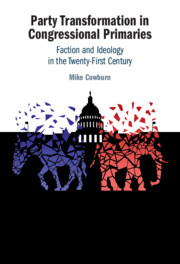Book contents
- Party Transformation in Congressional Primaries
- Reviews
- Party Transformation in Congressional Primaries
- Copyright page
- Contents
- Figures
- Tables
- Acknowledgments
- 1 Introduction
- Part I Primary Transformation
- Part II Party Transformation
- 4 A Most Likely Case
- 5 Selective Effect
- 6 Between-Election Adaptative Effect
- 7 Within-Election Adaptative Effect
- 8 Conclusion
- References
- Index
4 - A Most Likely Case
Factional Primaries in the Tea Party Era
from Part II - Party Transformation
Published online by Cambridge University Press: 09 November 2024
- Party Transformation in Congressional Primaries
- Reviews
- Party Transformation in Congressional Primaries
- Copyright page
- Contents
- Figures
- Tables
- Acknowledgments
- 1 Introduction
- Part I Primary Transformation
- Part II Party Transformation
- 4 A Most Likely Case
- 5 Selective Effect
- 6 Between-Election Adaptative Effect
- 7 Within-Election Adaptative Effect
- 8 Conclusion
- References
- Index
Summary
Part II of the book shifts in focus from primary transformation to party transformation. This chapter tests whether primaries can change parties under the most likely conditions: Republican factional primaries in the Tea Party era. Using a difference-in-differences design, this chapter shows that in this most visible case, pressure from the reactionary Republican faction in primary elections served to reorient the party rightwards. It therefore demonstrates that, under the right circumstances, primaries can contribute to partisan polarization in Congress.
- Type
- Chapter
- Information
- Party Transformation in Congressional PrimariesFaction and Ideology in the Twenty-First Century, pp. 123 - 135Publisher: Cambridge University PressPrint publication year: 2024

